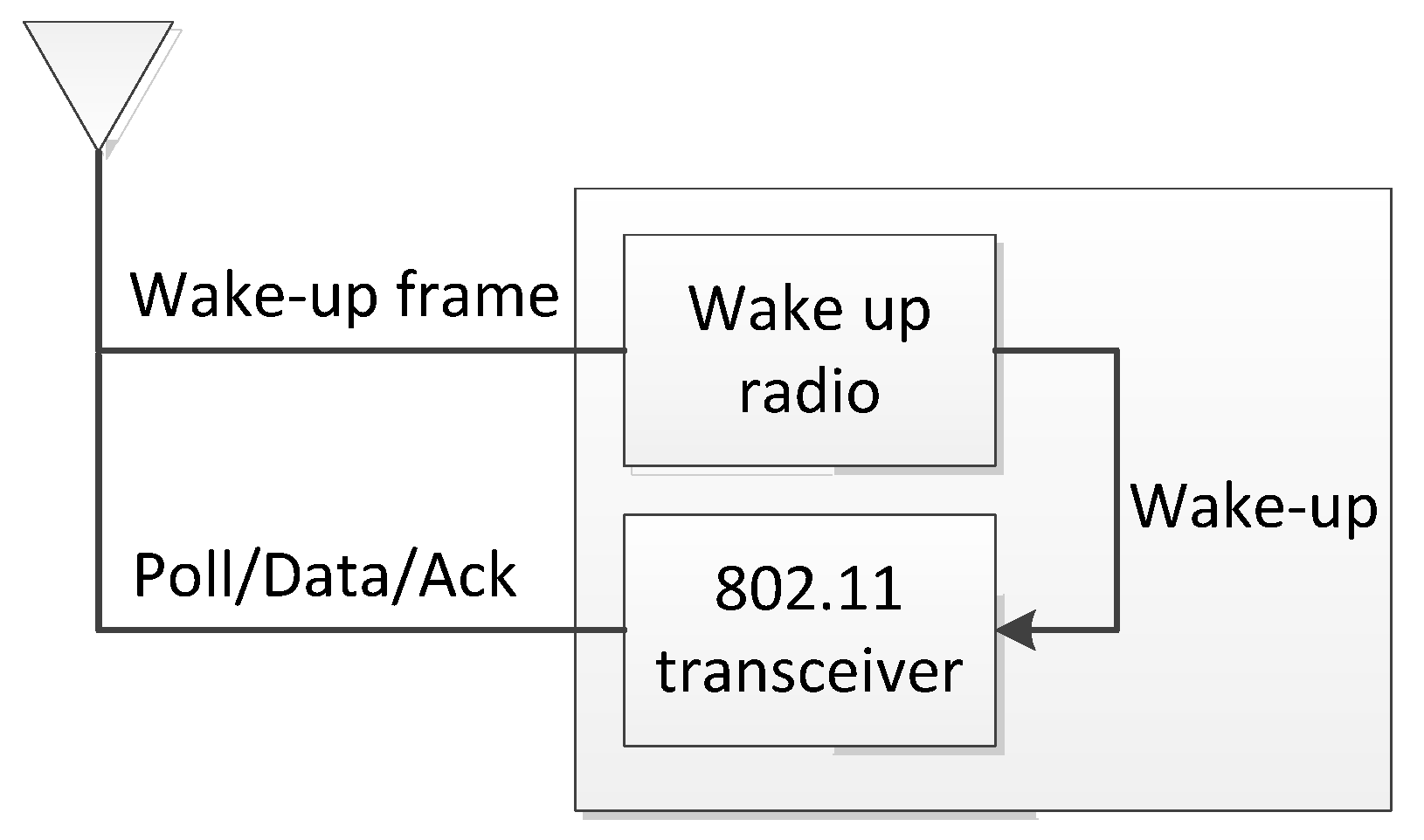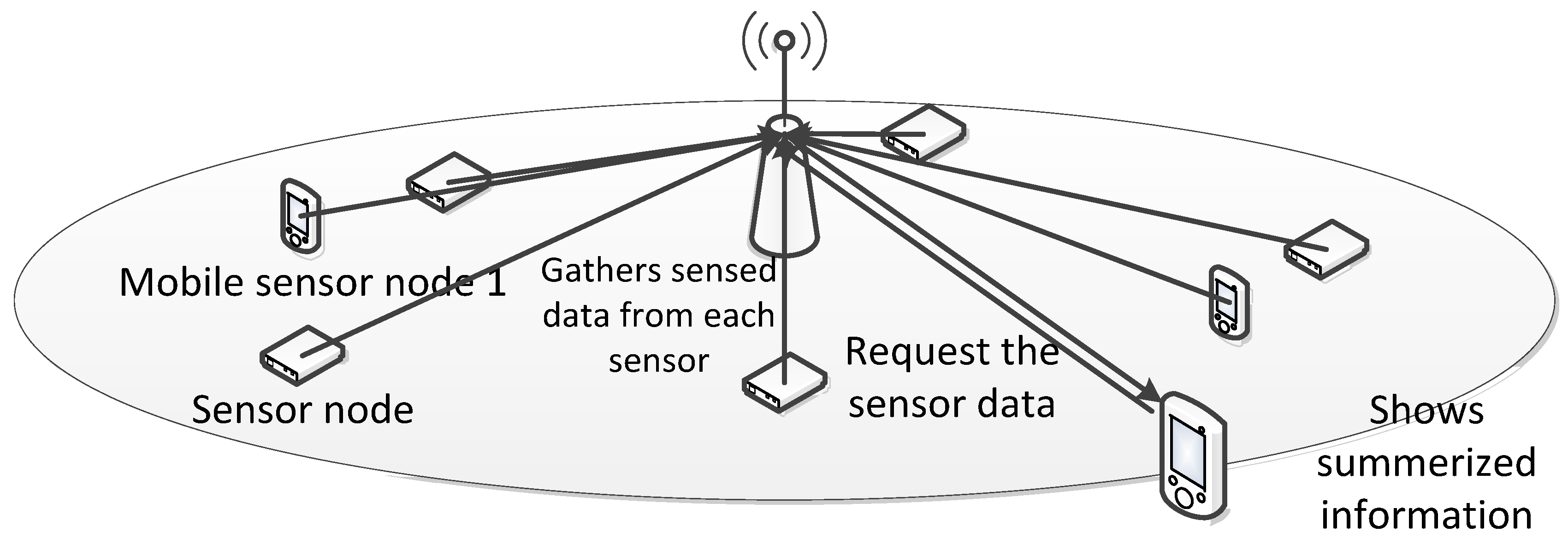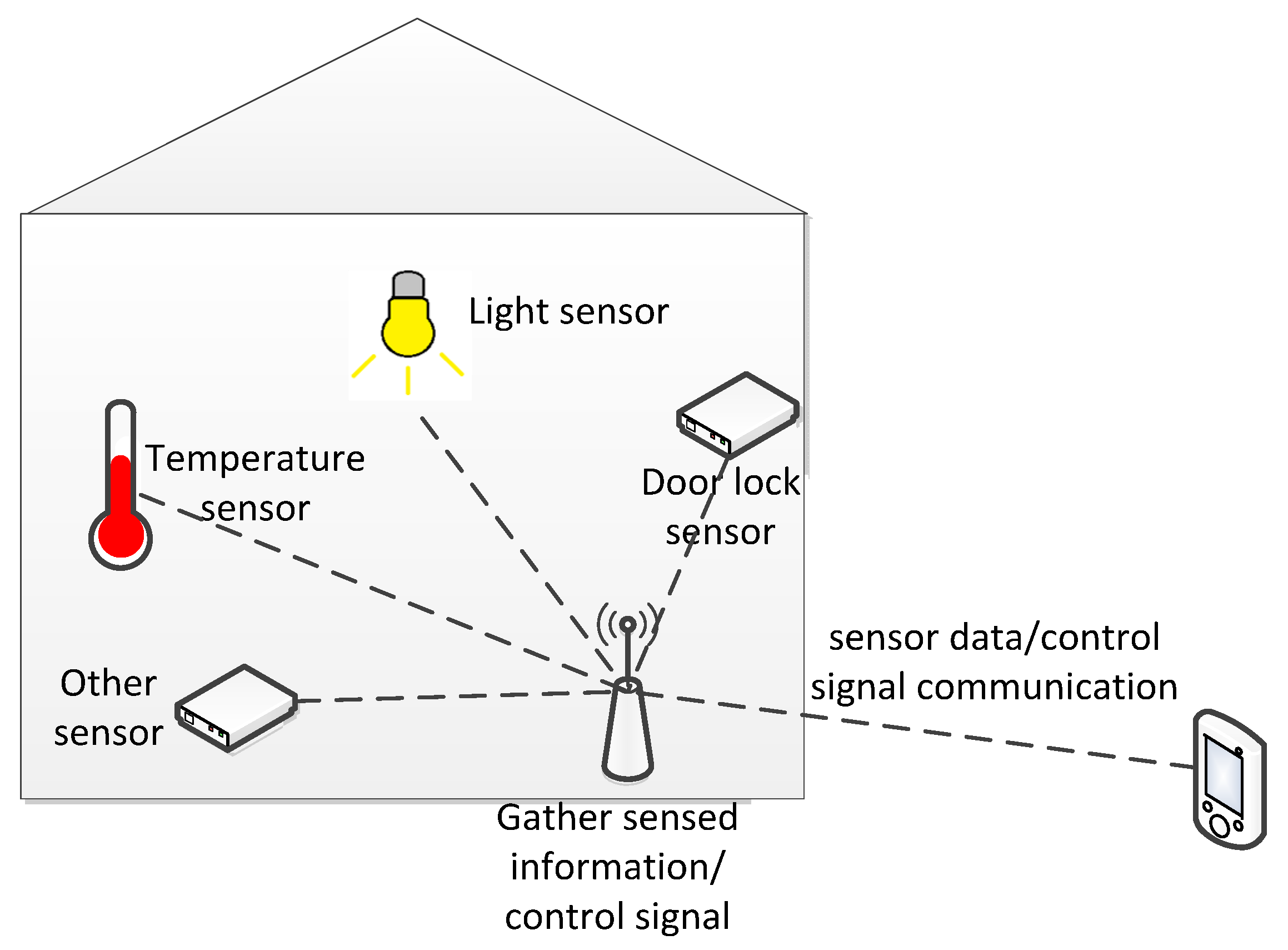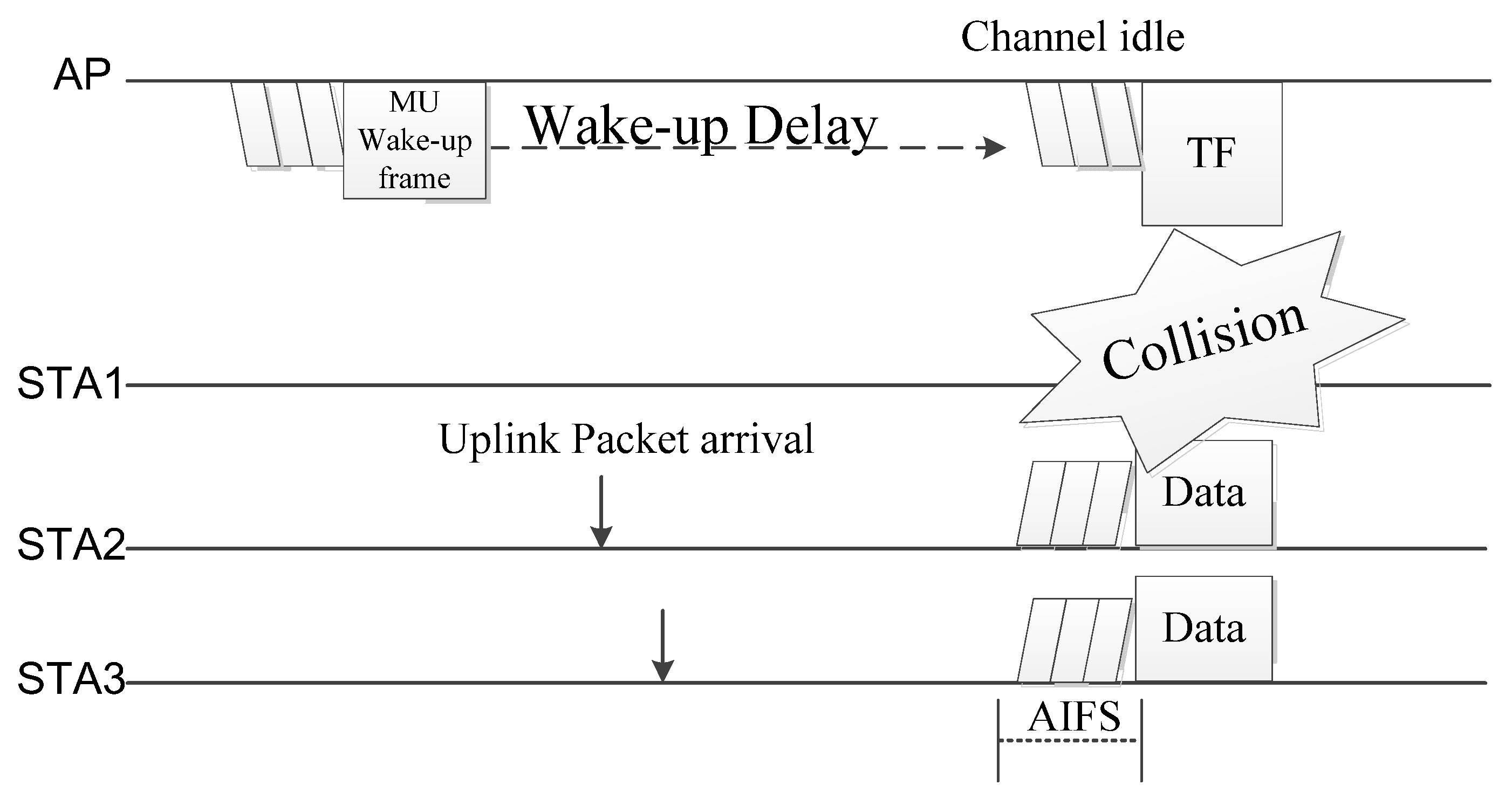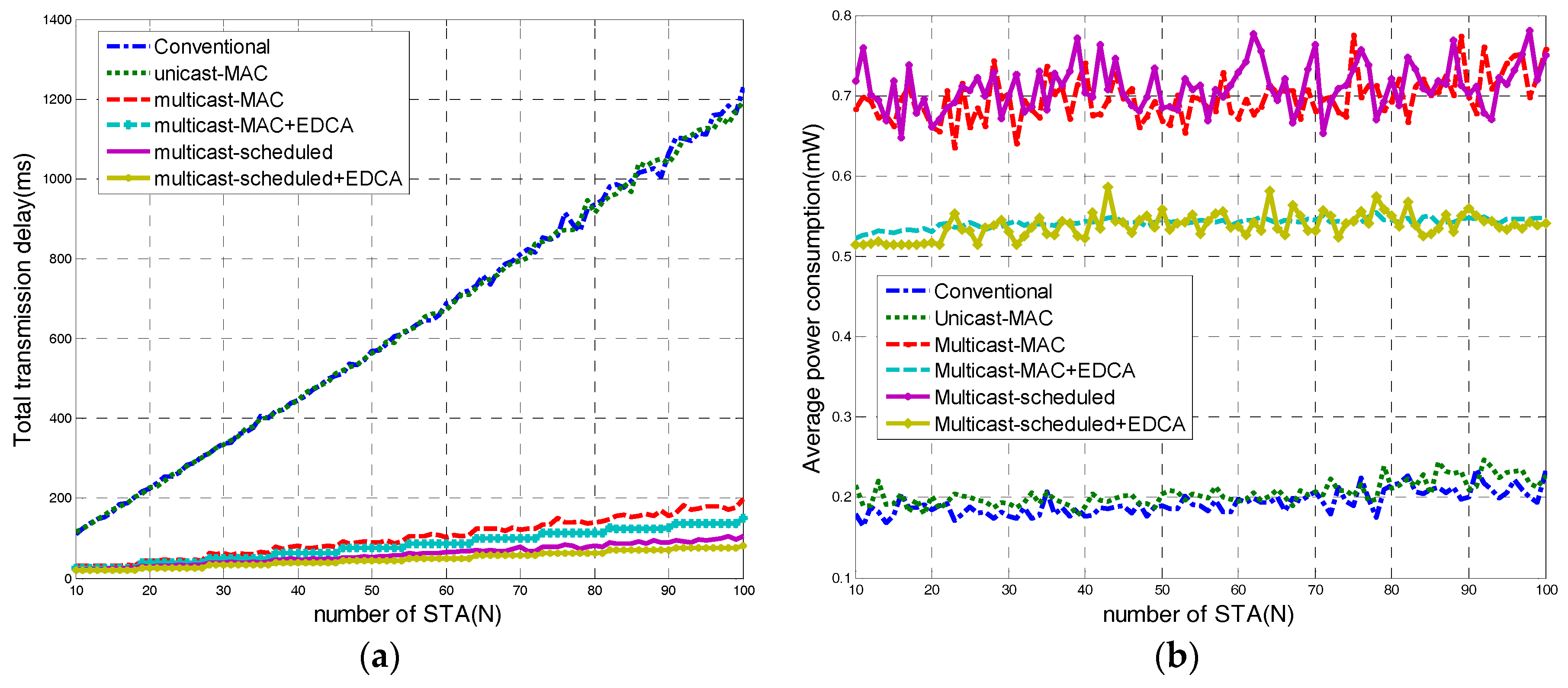1. Introduction
The Internet of Things (IoT) has become more widely used in various applications, such as home networks, wearable devices, cattle farms, and warehouses. In most IoT applications, IoT devices are battery powered, and low-power operation is therefore one of the key requirements of IoT devices. Moreover, there are various applications for IoT devices, and there exist a variety of communication scenarios as well as power and delay requirements.
The research on low-power communication has focused on sensor networks. Most of the previous works have focused on distributed sensor networks, which include tree construction, duty-cycled operation, and wireless energy harvesting operations [
1,
2]. In duty-cycled operation, sensors turn on and off their transceivers at predetermined times in order to reduce unnecessary power consumption when not transmitting or receiving data. Duty-cycled operation includes a synchronized approach [
3] and an asynchronous duty-cycled operation [
4,
5]. In [
3], a sending node scheduled transmission to a receiving node during a Data period, and performed a transmission procedure during a Sleep period. In [
4], a receiving node first transmitted a Beacon frame after it woke up, and a sending node transmitted data as a response to the Beacon frame. The power saving protocol in [
5] is an improvement on [
4] which considers multiple traffic flows. In [
5], each sensor woke up at randomized times using a pseudo-random number generator to avoid collision. In this method, if a sensor node wants to know the wake-up interval of the receiving node, it requests and receives the parameters of the pseudo-random number generator, and uses them to predict the awake time of the receiving node. Duty-cycled power saving protocols handle various systems and traffic models in sensor networks with a small overhead. However, since the previous duty-cycled power saving protocols were based on relay operation from a source node to a destination node, tree construction should be part of the framework. Therefore, the previous duty-cycled power saving methods in wireless sensor networks were not efficient for IoT devices with mobility. Moreover, the duty-cycled operation requiring wireless devices to turn on and off at scheduled times causes trade-offs between latency and power consumption.
The IoT scenarios are different from sensor network scenarios in several aspects, although they may appear similar. First, in sensor networks, once the devices are implemented, the sensors are static and rarely move, while IoT devices may move around. Second, while low traffic arrival is assumed in sensor networks, in IoT applications, there are various traffic patterns with different delay requirements. In order to deal with such dynamic IoT communication environments and various IoT traffic types, centralized network structures, such as in wireless local area networks (WLANs), are more efficient than distributed sensor network structures.
Several power saving methods and control systems for IoT operation have been proposed based on WLAN. In [
6], an AP power saving method based on the distance value of a station (STA) has been proposed. Whereas the idea of managing AP operation by average distance calculated by received signal strength indicator (RSSI) is simple and effective in the dense AP scenario, such an AP power saving method cannot reduce the power consumption of STAs. In [
7], a management system to control home appliances was proposed which takes into account the coexistence of heterogeneous networks. However, client nodes (home appliances) were only turned off and on based on their utilization. The proposed system in [
7] does not provide a power efficient communication method. In [
8], the authors have proposed an effective handoff procedure and AP selection mechanisms based on a certain medium access control (MAC) protocol called distributed queueing with collision avoidance (DQCA). By using the proposed effective AP selection mechanisms, STAs with mobility are able to reduce the number of handoffs, leading to reduced power consumption.
In the IEEE 802.11 group, the IEEE 802.11ah standard has been developed recently for low-power and long-range operation [
9,
10]. The main features of IEEE 802.11ah is narrow band transmission and scheduled wake-up operation called target wake time (TWT). IEEE 802.11ah effectively manages power consumption and a large number of STAs, but there is a trade-off between latency and power consumption. Since power management operation is based on a scheduled wake-up procedure, trade-off occurs because the latency for STAs to receive data depends on the length of the wake-up cycle.
In order to achieve the low-power operation and short communication delay required for battery powered WLAN devices, wake-up receivers were proposed in [
11,
12,
13,
14]. The wake-up receiver is a simple structured receiver which detects on-off keying (OOK) signals, enabling low-power operation and short transmission delay, simultaneously.
The previous power-saving operations using wake-up receivers are primarily for conventional sensor networks. The main scenario involves a large number of devices with a low traffic ratio and a simple structure. In [
15], the authors proposed the two-channel-based wake-up protocol. In the two-channel wake-up protocol, one channel is used to transmit data, and the other channel is used only to wake up neighboring STAs. In this protocol, the sender node may wake up all neighboring nodes through a wake-up channel when the sender has more data to transmit than the threshold. However, by using two channels without any indication, power may be wasted because all nodes which sense a signal in the wake-up channel should wake up and sleep including the nodes without data to receive, and other devices that operate at similar frequencies with the wake-up channel may wake up the sensor nodes. In [
16], the wake-up receiver protocol was proposed using a low-power operating wake-up receiver, based on the duty-cycled operation of the wake-up receiver. In the proposed operation, the duty-cycle wake-up receiver operation is proposed in order to achieve further power saving. The scenario in [
16] is also a distributed sensor network, and the operation includes the acknowledgment of a wake-up frame in order to ensure that the wake-up receiver in the receiving node awakes and successfully receives the wake-up frame. However, since those works assumed a low traffic arrival rate, in the dense communication scenario where a large number of communication devices are involved in communication with high traffic ratio or in the scenario where the collection of information from multiple nodes is required, these approaches may result in large delays.
In the IEEE 802.11 group, as the demand for IoT communication has evolved, the IEEE 802.11 amendment standard, IEEE 802.11ba has initiated standardization. IEEE 802.11ba defines WLAN wake-up radio operation for low-power WLAN devices like IoT devices. Because the wake-up radio using a wake-up receiver resolved the trade-off problem of duty-cycled operations in previous works, various applications with different traffic patterns, as well as delay and power-consumption requirements, are considered as the scenarios for IEEE 802.11ba. The wake-up radio operation developed in IEEE 802.11ba may be paired with any other IEEE 802.11 standards, including IEEE 802.11a/b/g/n/ac/ax.
However, although the IEEE 802.11ba standard includes various scenarios for IoT applications, it does not consider a traffic scenario where a mobile device requests sensed data from a large number of users. Moreover, the long wake-up delay of a STA causes large transmission delays in the case of the multi-user transmission scenario. In this paper, transmission methods for massive transmission scenarios are proposed. The proposed schemes are based on the joint design of uplink multiuser (MU) operation in IEEE 802.11ax and the wake-up radio operation of IEEE 802.11ba. Because the wake-up radio defined in IEEE 802.11ba can be added to any IEEE 802.11 standard, the MU operation in IEEE 802.11ax is adopted in order to significantly reduce the transmission delay. In addition, the scheduling method may utilize the wake-up delay to transmit to the other group of STAs, which reduces the entire transmission delay in the massive uplink MU scenario. In this case, MU transmission in wake-up radio may cause collisions, additional delay and power consumption because of simultaneous wake up and transmission. To resolve this inefficiency, a simple and efficient method to avoid collisions is added to the proposed method. The proposed scheme in this paper is able to ameliorate the inefficiencies of the previous works. The proposed scheme provides an efficient communication scheme to control trade-offs between latency and power consumption for multiple IoT devices with mobility without requiring proceeding transmission tree construction. The proposed scheme is based on realistic standards, IEEE 802.11ba and IEEE 802.11ax. The proposed scheme can be implemented without any standard change because IEEE 802.11ba can be used with any IEEE 802.11 standard, and in the proposed scheme, existing parameters are reused and make use of certain proposed values.
This paper is an extension of our previous work [
17], which was a preliminary study on the wake-up receiver-based WLAN MU communication scheme. Because the main focus of [
17] was waking up multiple STAs for MU communication, only power and delay comparisons between the conventional scheme and the proposed basic multiuser scheme are provided. In this paper, we propose a full extension of the MU transmission scheme along with a detailed description of the wake-up packet structure as well as the scheduling scheme and performance analysis. To do this, we performed extensive simulations and we present here our analysis. In the proposed scheme, we exploit salient features of IEEE 802.11ax to provide a low-delay communication scheme, while maintaining low transmission power.
The rest of this paper is organized as follows: In
Section 2, background on power saving algorithms and low-power wake-up receivers in accordance with IEEE 802.11ba are presented. In
Section 3, the target scenario and the conventional transmission scheme are explained. In
Section 4, the proposed structure and transmission schemes are presented. In
Section 5, the analysis of each method is given. In
Section 6, the simulation results are shown. Finally,
Section 7 concludes the paper.
3. Target Scenarios for IoT Device in IEEE 802.11ba
The use cases of IEEE 802.11ba include various proposed scenarios of IEEE 802.11ba, including various IoT applications. In [
22], scenarios including warehouses, cattle farms, and wearable devices were proposed. In those scenarios, there are a number of sensors that are controlled by a mobile device, which may request the sensed data from all of the sensors, as in
Figure 5. For example, in smart-home applications in
Figure 6, light sensors, temperature sensors, and door sensors transmit sensed data to a mobile device when the user wants it, and after the user is notified about the information, they may transmit control information to the smart home device to turn off the light, alarm, etc. In those IoT applications, the mobile device needs to acquire data from many sensors.
The conventional transmission method for this scenario in IEEE 802.11ba is based on unicast transmission, as shown in
Figure 7. With this method, the triggering frame that requests the sensed data from the STA may be implemented in the application layer. When the mobile data needs to collect the sensors’ data, the AP transmits the wake-up frame to the STA, and it then waits for the predefined wake-up delay in the association procedure. After the wake-up delay, the AP starts to transmit the triggering frame of the sensed data, which is denoted as a single-user (SU) trigger, to request the sensed data. The STA that wakes up from the wake-up frame and receives the single-user trigger sends the acknowledgment frame for the single-user trigger and transmits the data in the SU physical layer protocol data unit (PPDU) after a subsequent contention. For the successful transmission of data frames, the AP transmits the acknowledgment of the data frame, and starts the transmission procedure for the next STA.
However, in the conventional transmission procedure in this massive uplink scenario, the transmission delay is increased as the number of STAs increases because of the repetition of the entire procedure for each STA. Therefore, the conventional method based on unicast transmission may not be sufficient to meet the required delay.
4. Proposed System for Massive Uplink Scenario
To reduce the entire transmission delay in a massive uplink scenario, a simple approach in unicast transmission can be to aggregate the acknowledgment frame and data. However, since the transmission procedure is still repeated for each STA, the performance improvement is limited. To reduce the entire delay significantly, the IEEE 802.11ax transmission system can be applied with the wake-up receiver system, as in IEEE 802.11ba, because the wake-up radio in IEEE 802.11ba is supplementary to other IEEE 802.11 radios. In the proposed system, in addition to the conventional IEEE 802.11ax system of the wake-up device, the scheduling scheme for MU operation with wake-up radio and the enhanced distributed channel access (EDCA) parameter set operations are jointly designed. In the joint design of MU scheduling and EDCA parameter setting, the goal of the scheduling operation is to further decrease the data transmission delay in the MU transmission procedure, and the goal of the EDCA parameter operation is to prevent collisions caused by woken-up STAs’ transmissions. The proposed system includes the transmission procedure, as well as a collision-avoidance method which can be used in IEEE 802.11ba.
4.1. Wake-Up Frame and Data Transmission for Triggering Uplink Transmission from Multiple Users
The wake-up and data transmission procedure can be operated in unicast transmission (single-user operation) or multicast transmission (MU operation). In unicast transmission systems, the transmission procedure is repeated for each STA. On the other hand, in the multicast transmission procedure, the transmission procedure is based on a group of STAs, and STAs in the same group may communicate with the AP simultaneously.
4.1.1. Aggregation of Uplink Data with the Acknowledgment of Trigger Frame (Unicast-MAC)
In single-user transmission, the data transmission procedure causes the two-channel access process after the wake-up frame transmission. To reduce the additional contention delay in data transmission, the STA that receives the single-user trigger may respond with an acknowledgment frame aggregated with the data frame, as shown in
Figure 8. In this procedure, the single-user trigger includes vendor-specific information to aggregate the acknowledgment frame with the requested data frame. The STA that receives the single-user trigger with the information sends an acknowledgment frame aggregated with the data frame. After the reception of the aggregated frame, the AP sends the acknowledgment frame to indicate reception, and it repeats this procedure for all of the STAs. In this scheme, there is contention for the transmission only when transmitting the single-user trigger, and no additional contention is required to transmit the data frame.
4.1.2. Multi-User Transmission Procedure as in IEEE 802.11ax (Multicast-MAC)
The repetition of the entire transmission procedure causes a large delay as the number of STAs increases, as the long wake-up delay and contention procedures are repeated. In order to reduce the repetition, we can apply the MU transmission procedure adopted in IEEE 802.11ax. As depicted in
Figure 9, in the MU transmission with wake-up radio, after the wake-up packet for multiple users is transmitted, the data transmission procedure starts with the TF, as in the uplink MU OFMDA procedure of IEEE 802.11ax. The response of the TF can be a data frame aggregated with the acknowledgment of the TF, as in the unicast-MAC procedure. After the successful reception of the uplink MU OFDMA frame, the AP transmits a multi-STA blockack frame to respond to multiple STAs simultaneously.
This procedure reduces the delay in the entire transmission procedure simultaneously, but the AP continuously waits for the wake-up delay for each transmission procedure. Because the wake-up delay is longer than other transmission delays, the repetition involved in waiting for a wake-up delay is inefficient.
4.1.3. Scheduled Operation for IoT Devices (Multicast-Scheduled)
Although MU transmission reduces the transmission delay significantly, the repetition of the entire transmission procedure results in a large end-to-end delay because the AP waits for a long wake-up time in each group. To reduce the inefficiency due to the wake-up delay, the AP may transmit a wake-up packet to another group during the wake-up delay. In this scheme, as in
Figure 10, the AP schedules the MU data transmission procedure of the previous group and the wake-up packet of the next group in the wake-up delay. For example, in Group 2’s wake-up delay, the data transmission procedure of Group 1 and wake-up frame to Group 3 are scheduled. Using the scheduling procedure, the wake-up delay of each group is cascaded and the entire data transmission delay can be reduced.
4.2. Discussion on the Wake-Up Frame Format for Multi-User Operation
To apply the MU transmission procedure as described in previous section, there is a need to wake up multiple STAs. In addition to the proposed methods in [
17], there are some recent proposals for the MU wake-up frame format in IEEE 802.11ba, although it is still under standardization. In [
23], the MU format of the wake-up frame is proposed. Because the wake-up frame consists of a 20-MHz IEEE 802.11 preamble and a narrow-band wake-up payload, the wake-up payload may be transmitted in a frequency-division multiple access (FDMA) OOK signal, as depicted in
Figure 11. To apply this wake-up frame structure in the association procedure, STAs should negotiate the frequency band on which to receive the wake-up packet with the AP. After the negotiation, wake-up receivers in STAs only need to scan the predetermined band in order to receive the wake-up packet. Another proposal for the MU wake-up frame [
24] is to use a group identifier (ID) in the receiver address field. The group ID should be negotiated with the AP when the STA is associated or when it switches to the wake-up mode. To use the group ID, the grouping method is important, because there may be unnecessary wake-up procedures, which causes power wastage.
4.3. EDCA Parameters for Multiple STA Operation
The MU transmission procedure reduces the end-to-end delay of the entire transmission, but it also increases the collision probability as the number of STAs in the MU OFDMA procedure increases. As depicted in
Figure 12, each STA may have an uplink packet arrival, and the contention procedure is operated when there is an uplink packet in the STA during the wake-up delay. Because in WLAN transmissions procedure with EDCA, the STA may start to transmit the data when the channel is idle for the arbitration inter-frame spacing (AIFS) period, there is a high probability that there will be collisions.
Collisions in the wake-up receiver procedure cause severe degradation in terms of power efficiency because the AP should then restart the wake-up frame transmission. In particular, if the TF encounters a collision, STAs in the MU transmission procedure remain in an idle state and wait for the wake-up frame and subsequent TF for the long wake-up delay.
To prevent collisions, a shorter AIFS can be applied to the TF, which gives high priority to the transmission of TF. By implementing the short AIFS for the TF, STAs that have uplink data defer their transmissions, which reduces the probability of collisions. The implementation of a short AIFS parameter in the MU TF is possible using the EDCA parameters determined by the AP because the IEEE 802.11ax standard enables the AP to decide the EDCA parameter of each access category (AC), and the trigger frame can use any access category to access the channel.
